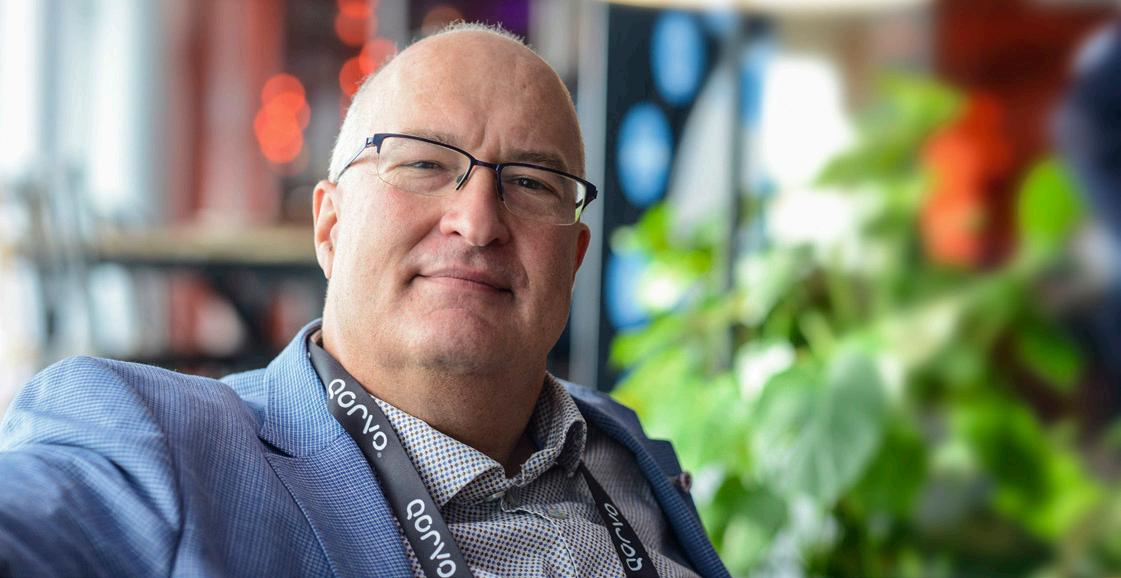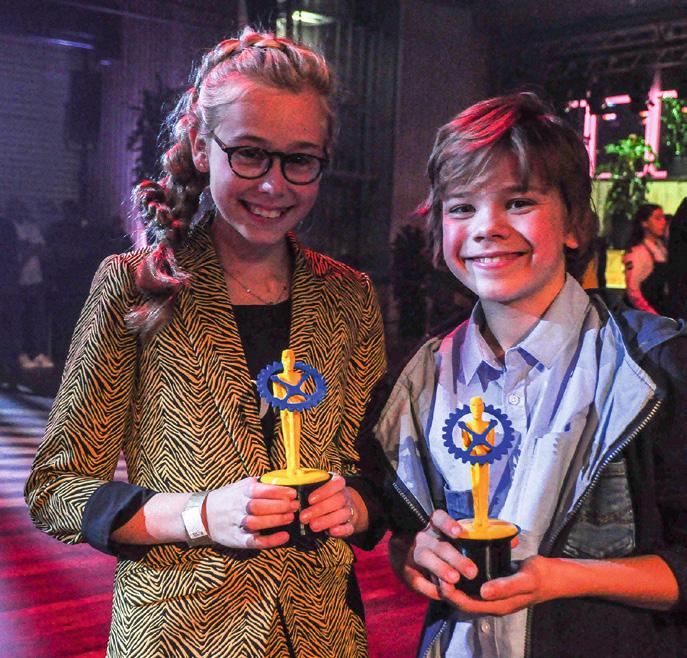
13 minute read
WaveLAN: the tech that brought Wi-Fi to the world
Wi-Fi, one of the most recognizable technologies on the planet, turns 20 this year. While Steve Jobs and Apple had a hand in bringing it to the masses, the building blocks of the world-renowned technology sprouted from right here in the Netherlands. One of its founding fathers, Bruce Tuch, discusses the journey from the early days of the Dutch-developed WaveLAN to the globally recognized Wi-Fi.
Collin Arocho I t was 1985 when the American Federal Communications Committee (FCC) authorized new rules for spread spectrum. In radio communications, spread spectrum techniques are used to distribute a signal across a frequency domain, which results in a wider bandwidth. This wider bandwidth helps secure communications while also reducing interference or noise.
Advertisement
“I could have never imagined while working at NCR Nieuwegein on this feasibility study, what this seed would eventually grow into,” recollects Bruce Tuch. Tuch, the former CTO at WCND Nieuwegein (formerly NCR Systems Engineering) was a core developer of WaveLAN, the predecessor of Wi-Fi. At the WaveLAN20 symposium in the Utrecht suburb, he came to celebrate 20 years of Wi-Fi and reunite with many of the others that contributed to the world-altering technology.
RF chops At the time, local area networks (LANs) were operating at a minimum of 1 Mb/s, which was the standard for internet connectivity. But engineer Don Johnson of the National Cash Register Corporation (NCR) technology research, based in Dayton, Ohio, had the idea to utilize the new spread spectrum to establish wireless cash registers. The problem was figuring out how. For Tuch, the timing of all of this couldn’t have been any better.
“The timing was perfect for me. I was a kid from Brooklyn, living in the Netherlands. I got my RF chops while designing chips for televi
sion tuners at Philips in Eindhoven, but I was looking to move closer to Utrecht,” remembers Tuch. “NCR saw an opportunity to develop within this wireless domain and they gave me a chance. All I had to do was convince corporate to fund the feasibility study – and that’s exactly what we did.”
Goosebumps In these days, there were two main methods for spreading spectrum under the new FCC guidelines: direct sequence and frequency hopping. Direct-sequence spread spectrum (DSSS) is a modulation technique that uses codes to scramble and spread data by short radio pulses over large bandwidths. For every bit you send out, you’re actually sending out a code that represents that bit, called a chip. If you spread by a factor of 10, you send out 10 chips for each bit. The alternative approach, frequency hopping, jumps from channel to channel to modulate and spread the radio signal. “Early in the system analysis, we decided that at the 1-2 Mb/s parameters, and especially looking toward the future of higher speeds, frequency hopping would not have the range, nor the robustness that direct-sequence spread spectrum offered us and we weren’t going to put our energy there,” Tuch recalls.
In the feasibility testing, engineers determined that achieving 1-2 Mb/s speeds in the retail market was possible, but only with minimal spreading of the signal, by no more than a factor of 10 or so. The problem: the FCC’s rules were incredibly vague and didn’t specify how much the signal needed to be spread. “We knew we had to spread the spectrum, but we had no idea by how much,” says Tuch. “The military was spreading signals by a factor of hundreds or thousands, but trying to reach our speed parameters in the retail environment, spreading that much wasn’t an option.”
Looking for concrete answers, Tuch jumped on a plane to Washington DC to meet with the FCC and find out the minimal spread allowed. Expecting to get an answer with numbers like 64 or 128 (used in military antijamming applications), he was left flabbergasted when he got the FCC’s official answer: 10. “I got goosebumps leaving that meeting,” exclaims Tuch. “I think I danced out of the FCC building. This was great! I knew we could do a 2 Mb product.”
First product On his return to NCR, Tuch was thrilled to share the news. The competition was all spreading by much higher numbers, based only on misinterpretations and assumptions of the FCC guidelines. With his new-

Bruce Tuch at the WaveLAN20 symposium, catching up with many of the others that contributed to the world-altering technology
found clarity, he knew his team was on the cusp of something big. Over the weekend, team design engineer Hans van Driest had cracked a code to spread a signal to 11 chips long – just over the FCCs threshold. “Once I saw this code, my heart skipped a beat,” reminisces Tuch. “I knew this was a defining moment, a differentiating milestone.” The code was a ‘reinvention’ of the Barker code, which was commonly used in radar systems and had all the properties needed for a robust indoor communications system.
Armed with this information from the FCC, the results of the feasibility study and the 11-chip Barker code, NCR Nieuwegein went to corporate management with a proposal for a vertically integrated product for the retail market. Because of their expertise from the study, NCR decided that Tuch’s group within the company was the best suited to make and develop the product and by the end of 1990, they had done just that. “That’s when we made the first WaveLAN 2 Mb product and that was quite revolutionary. Once

we launched that, suddenly companies were taking notice of the speeds that we were capable of,” remembers Tuch. “We really set a directional pace and showed that higher speeds were possible, but now everyone was ready to jump into the arena.”
Wireless Andrew By the mid-90s, Carnegie Mellon had already spent a decade in creating a vast and open infrastructure for university researchers, professors and students to access the Internet, called the Andrew Project. After the release of WaveLAN, provost Alex Hills became interested in pursuing a wireless adjunct to the project that he called Wireless Andrew. The university reached out to NCR with the idea of launching the first fullyintegrated wireless LAN on the entire campus – a-first-of-its-kind project. A launching customer of sorts.
The initial objective at the rollout of Wireless Andrew was to allow researchers to conduct further research into wireless connectivity. For instance, in the field of robotics by connecting robots wirelessly, rather than through wires. Also, in the field of protocol research, learning how devices behave when switching between wireless and cellular networks. But after its release in 1997, Carnegie Mellon and NCR got some interesting results. Before long, they
The first WaveLAN prototype board

noticed that it wasn’t so much the researchers, but students that were using the wireless network.
“The network was made so that it was hard to get into without passwords and control, but students are really good at what they do,” laughs Tuch. “They figured out how to get in and started using it much more than anyone else on the campus. They became enthralled with it. The kids were innovators. They weren’t just using it for research; they were connecting with their friends, writing papers and reports and, maybe most of all, gloating to their friends at other universities about Carnegie Mellon having the first campus-wide wireless LAN.” This was just a glimpse at the potential what wireless LANs could offer.
Married couple Working with other experts in the Institute of Electrical and Electronics Engineers (IEEE) 802 group, which establishes the standards for local area networks, a new set of protocols was ratified for a new specific standard for wireless LANs – 802.11. Essentially, the new approved standards adopted the features of the WaveLAN product – DSSS using the same Barker code. But with these new standards in place, Tuch’s attention was already turned to achieving the next generation of wireless connectivity with speeds as fast as 10 Mb/s.
After some infighting with chip vendors Harris Intersil, which slowed progress, the two companies opted to bury the hatchet. Now putting their heads together, utilizing an improved coding scheme from Richard van Nee, the duo submitted a joint proposal for IEEE 802.11 approval – 802.11b, which established a new specification that extended speeds up to 11 Mb/s on the same 2.4 GHz band – that was

The first interface with Wi-Fi certificate
Our products
Controllers and GUI's Small signal generators Amplifiers
Applicators 19'' generator units OEM generator parts
13.5 MHz until 2.5GHz 5W until > 30kW
pinkRF
designs develops and manufactures RF Energy systems for Industrial, Medical, Pharmaceutical and Scientific applications
Find out more at www.pinkrf.com Our services
Consultancy Training Project management Design & development
Manufacturing
Process development Permittivity mea surements EM-Modeling

ratified almost immediately. Tuch: “At that time, the IEEE meetings weren’t going anywhere; it was just mud wrestling between two of the bigger groups. But at the next meeting, when everyone expected us to argue and entertain them, we came in like a married couple walking down the aisle.”
Apple Airport Around 1998, simultaneously with 802.11 discussions, Steve Jobs brought in Dick Allen to help him find a supplier of the ‘best-in-class’ wireless technology to be integrated with the release of Apple’s iBook. Initially, this was for the 2 Mb/s standard. Allen, who regularly attended the 802.11 meetings, reached out to Tuch to find out just how close they really were to the 11 Mb/s product. Luckily for Apple, Tuch and his team were on the verge of a major breakthrough.
“It was really good timing for Apple because you know, they don’t want to launch something when someone else has it too. They want to be first,” explains Tuch. “When they launched this thing, they were the first because we worked with them om the early stages and during our chip development. This way, they could announce that not only did the iBook have wireless LAN, but it was the first wireless LAN capable of 11 Mb. No one else had it. But even more importantly, it was extremely affordable at only 99 dollars because we made the business decision to give them the product, basically at cost.”
There was one hiccup, however. Just before its release, Apple discovered they had a big problem. While the laptop was fully integrated with the wireless LAN card, it was having trouble connecting to the Airport base station – the signal had disappeared. “It turns out, this beautifully sleek and shiny-metallic base station, which was approved by Jobs, was essentially a Faraday cage,” quips Tuch. “Steve had a bit of a reality distortion field around him, so nobody wanted to enter that field. If you did, once you left, you might suddenly believe you could change the laws of physics.
The first Apple iBook with WaveLAN
Fortunately, by changing the product to plastic, they could still achieve the shiny look, only this time, the device would work.” Crisis averted.
Windows XP Just after this, in 2000, wireless LAN became known simply as Wi-Fi – a trademark that has become so popular, in recent years the term is often used as a synonym for the Internet. The technology was out there, and the world was buying in. Suddenly, software developers from Microsoft were calling the engineers in Nieuwegein – who were now part of Lucent – with lists of technical questions about the WaveLAN card. Microsoft was ready to include wireless LAN in its next OS – Windows XP.
Tuch boarded a plane and flew to Seattle for a meeting at the Microsoft HQ with Jawad Khaki, the corporate VP in charge of Windows OS networking. Microsoft wanted to make sure that Windows XP, and all future releases, were equipped with native Wi-Fi. They were looking to integrate a WaveLAN-like look and feel to show access points in the barcoded signal

levels on the connections screen, which by 2001 was fully integrated.
Tuch: “The advantage for us was that we were early to work with them to integrate. When XP launched, we had already passed their Windows compatibility test, known as WHQL, and already had the certificate that our solution was compatible with the system. Furthermore, because of our close working relationship with the software company, when XP launched, they told their entire community of users and all their OEMs around the globe that the Lucent solution was the card that they’d been using and had shown to have great operation. Suddenly PC OEMs were calling up looking to get their Lucent 802.11b cards. So, that definitely didn’t hurt us.”
WaveLAN20 At the WaveLAN20 symposium held on 29 October in Nieuwegein, WaveLAN, the precursor of Wi-FI, was presented with the IEEE Milestone for developments with significant achievements that have stood the test of time for at least 25 years.
DISCOVERY FACTORY 10 YEARS
On 22 October, Eindhoven’s Parktheater was all about technology. In a beautiful setting, 300 employees, sponsors and friends of the Discovery Factory celebrated the 10-year anniversary of the science center of Brainport region Eindhoven.
rom past to future Founders Chris Voets and Hugo Vrijdag kicked off the evening telling stories from the past. They started the Discovery Factory back in 2009 in a former Philips factory in Eindhoven, based on their educational program ‘The Inventors’ using an innovative storytelling concept. A lot of partners (see the bottom of this page) also contributed to this walk down memory lane. With their help, the Discovery Factory has inspired 250,000 children for a future in design and technology. From being innovative and always aiming for a sustainable future, the subject rapidly shifted to the Discovery Factory’s latest developments. F
Movie premiere The latest developments include the educational program “The Inventors’ Best Kept Secret”, aimed at children aged 9 and 10. A new movie from director Chantal de Jong is the starting point of this educational project. All invitees witnessed the official movie premiere. It tells the story of a young inventor named Finn who’s eager to come up with a new invention. His friend Kiki studies people. In an exciting adventure, they discover that together, they make the perfect team creating inventions that really contribute to people’s needs! The movie was the climax of the evening. But more importantly: from now on, children, parents and teachers can watch the movie in the Discovery Factory and be inspired for a future in innovation and technology.
Educational program for schools near you In connection with the movie, a primary education program is available. Does your company want to support schools in your region with technology education? Contact the Inventors at the Discovery Factory (info@deontdekfabriek.nl). They’ll use their 10-year experience for enthusing all school children and youngsters for a future in tech – even if it means organizing an inventors contest on behalf of your company!
The Discovery Factory is there to inspire youngsters for a future in design and technology. Projects are supported by tech companies such as ASML, Brainport Industries, Daf Trucks, Frencken Europe, Hager, NTS Group, Philips, Stam en De Koning and VDL Group, and by Bits&Chips as the media partner.













